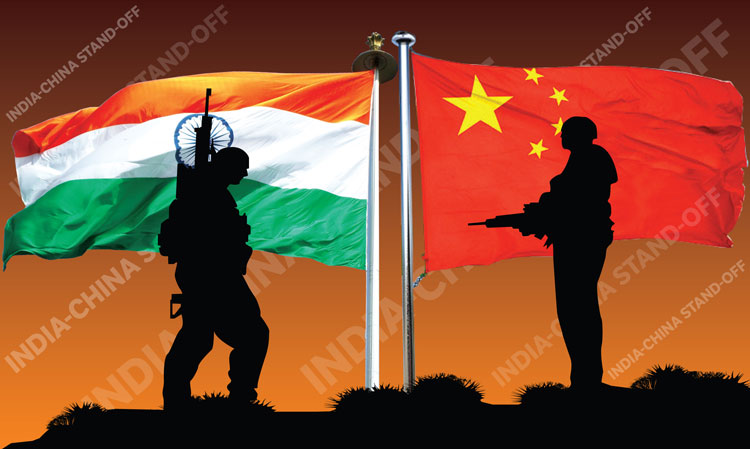INDIAN ARMED FORCES CHIEFS ON
OUR RELENTLESS AND FOCUSED PUBLISHING EFFORTS

SP Guide Publications puts forth a well compiled articulation of issues, pursuits and accomplishments of the Indian Army, over the years

I am confident that SP Guide Publications would continue to inform, inspire and influence.

My compliments to SP Guide Publications for informative and credible reportage on contemporary aerospace issues over the past six decades.
Indo-Chinese Conundrum
India is witnessing its worst-ever border tensions with China since 1962 with both countries bringing forward thousands of troops along the Line of Actual Control (LAC) in eastern Ladakh. Is this mere Sabre rattling by China or will it result in a larger conflict between India and China?
 |
The Author is Former Director General, Mechanised Forces, Indian Army |

The relations between India and China have been a mix of cooperation, competition and mistrust; cooperation on economic, environmental, and transnational security issues; competition due to contradicting spheres of influence, geopolitics and political alliances; and there is intense atmosphere of mutual distrust due to the unresolved border dispute.
The differing perceptions of both India & China on the Line of Actual Control (LAC) have led to frequent standoffs. Yet most of these were have been resolved at local commanders’ level. However, the current transgressions in Pangong Tso Lakeand Galwan Valley (05/06 May) and other intrusions (Naku La – 8th/9th May) are not routine but a well-planned orchestrated move approved at the CMC level. The increased level of troop deployment by both sides has heightened tensions.
The current transgressions in Pangong Tso Lake and Galwan Valley and other intrusions are not routine but a well-planned orchestrated move approved at the CMC level.
The moot question is that why is China acting in a belligerent way in its neighbourhood? China has already embarked on intimidation and coercive tactics in South China Sea and has heightened tensions with Malaysia, Vietnam and other nations of the region; it has removed the word peaceful in its reunification plans of Taiwan and has approved the new security law in Hong Kong leading to more protests. It does seem to be diversionary tactics to draw the attention away of the world from the pressure of investigation into the origin of COVID and China’s role in it. At the same time, it helps the Chinese leadership to drum up nationalist feelings and distract its own populace attention away from mishandling of COVID crisis, the consequent economic slowdown and unemployment.
Therefore, Chinese recent transgressions against India meets more than the eye. These are well planned and coordinated with sizeable force with artillery in support. India too has built up its forces. China knows that transgression through patrolling actions is different from what they are doing now. China may have managed to do salami slicing in South China sea but it will not be able to do the same against India. China knows it too well as Nathu La (1967) and Doklam will be fresh in their memories. India has changed! China will be flawed in its approach if they believe that it will be able to intimidate India and coerce her to change its policy on border infrastructure development or any other issue.
Beijing is pursuing a two-pronged strategy in its relationship with India – it combines engagement with deterrence.
Everyone talks that the 21st century is going to be Asia’s century and China wants to be leading. However, China is wary of India’s aspirations and wants her to remain locked in local disputes. China has used the policy of coercion with India by using its relationship with Pak to keep the threat of two front war alive, and by thwarting India’s entry into global institutions. At the same time, it keeps up with border incursions but balances out with resolving these disputes through border mechanisms yet keeping the pot boiling. Beijing is pursuing a two-pronged strategy in its relationship with India – it combines engagement with deterrence. China’s strategic literature continues to list India as one of China’s most likely opponents in regional conflicts (the other being Vietnam and Taiwan).
As long as India denies China the prospect of “teaching a lesson” through a short military operation, there will no conflict.
Is there going to be a conflict on this issue? India has resolute leadership which is pragmatic and mature. During the Doklam crisis, the leadership of both countries acted in a realistic and mature way. Over the period, the two countries have attempted to gradually construct a relationship which has acquired a global and strategic perspective. China’s Foreign Ministry spokesperson in a response to India’s claim that China has sent troops to the China-India border said that ‘China and India have sound border related mechanism and communication channels. Both parties have the ability to properly resolve relevant issues through dialogue and consultation.’ However, this does not indicate that there is going be an early resolution of the crisis.
The Chinese are students of Sun Tzu and nothing comes to their geopolitical strategic thinking more naturally than ‘feint and deception’ and making the opponent surrender without a fight. As long as India denies China the prospect of “teaching a lesson” through a short military operation, there will no conflict. Chinese will never enter a war without a clear political aim and unless the achievement of that political aim is a certainty, they will not risk “losing face”. Besides China faces a multitude of challenges on domestic and international fronts and hence, the present intrusions leading to India China border war seems improbable. However, India needs to be wary of China’s designs and should continue to build its Military security capability so that it can stand firm to China’s coercive strategy.





